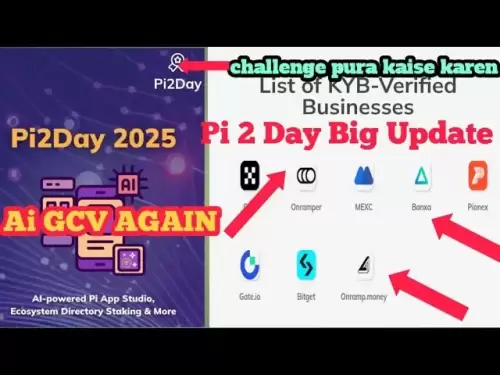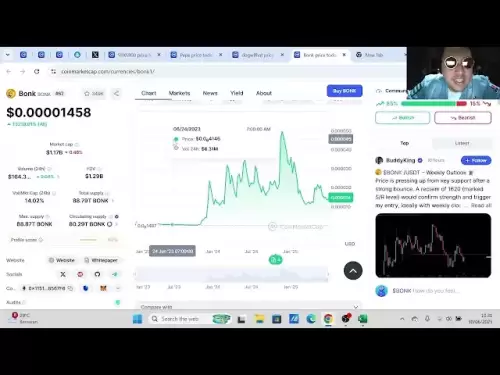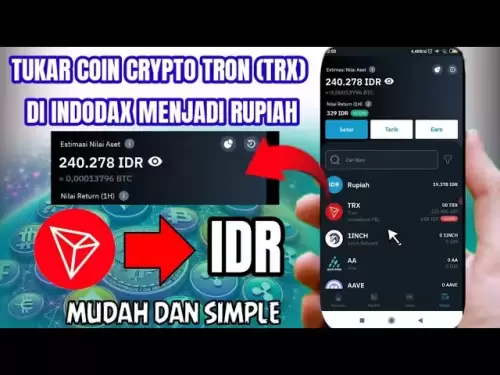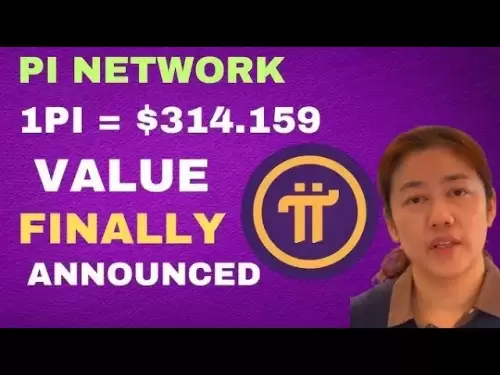-
 Bitcoin
Bitcoin $108,489.6704
1.13% -
 Ethereum
Ethereum $2,502.0528
2.92% -
 Tether USDt
Tether USDt $1.0002
0.00% -
 XRP
XRP $2.1941
0.51% -
 BNB
BNB $655.3375
1.00% -
 Solana
Solana $151.5977
1.27% -
 USDC
USDC $0.9999
0.00% -
 TRON
TRON $0.2768
0.32% -
 Dogecoin
Dogecoin $0.1676
2.86% -
 Cardano
Cardano $0.5675
0.98% -
 Hyperliquid
Hyperliquid $40.6109
7.48% -
 Bitcoin Cash
Bitcoin Cash $500.7746
2.09% -
 Sui
Sui $2.8328
2.03% -
 Chainlink
Chainlink $13.4452
1.26% -
 UNUS SED LEO
UNUS SED LEO $9.1623
0.39% -
 Avalanche
Avalanche $18.2267
2.24% -
 Stellar
Stellar $0.2382
0.00% -
 Toncoin
Toncoin $2.8885
1.68% -
 Shiba Inu
Shiba Inu $0.0...01159
0.91% -
 Litecoin
Litecoin $87.1827
0.88% -
 Hedera
Hedera $0.1511
2.90% -
 Monero
Monero $315.4992
-0.59% -
 Polkadot
Polkadot $3.4663
2.34% -
 Bitget Token
Bitget Token $4.6118
-0.65% -
 Dai
Dai $1.0000
-0.01% -
 Ethena USDe
Ethena USDe $1.0003
0.02% -
 Uniswap
Uniswap $7.2989
4.69% -
 Pepe
Pepe $0.0...01003
5.73% -
 Aave
Aave $275.5616
7.15% -
 Pi
Pi $0.5181
-2.49%
How are ERC-20 tokens created on the Ethereum blockchain?
ERC-20 tokens are created by deploying Solidity smart contracts on Ethereum, defining token properties like name and supply. Tools simplify this process, but understanding Solidity is crucial for customization, while gas fees are incurred for deployment and transactions.
Mar 13, 2025 at 01:30 pm
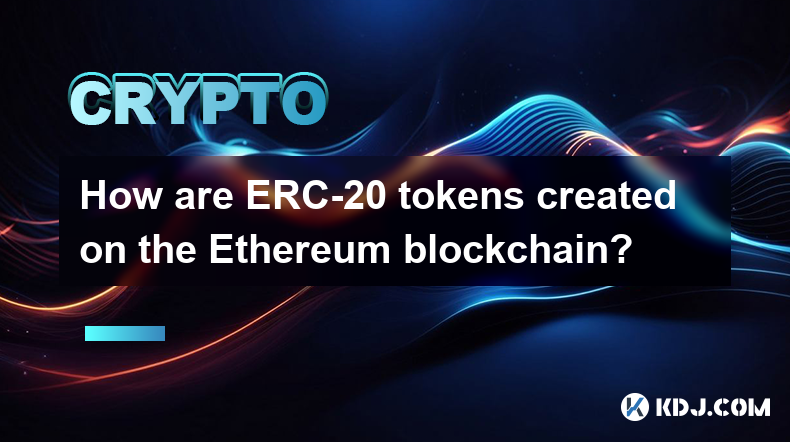
Key Points:
- ERC-20 tokens are created by deploying a smart contract to the Ethereum blockchain.
- This smart contract defines the token's properties, such as name, symbol, total supply, and decimals.
- Several tools and platforms simplify the process, including online IDEs and dedicated token creation services.
- Understanding Solidity programming is crucial for customizing token functionality beyond basic ERC-20 standards.
- Gas fees are incurred during deployment and subsequent transactions involving the token.
How are ERC-20 Tokens Created on the Ethereum Blockchain?
ERC-20 tokens are essentially digital assets built on the Ethereum blockchain, adhering to a specific technical standard (ERC-20). This standard ensures interoperability between different decentralized applications (dApps) and wallets. Creating an ERC-20 token involves deploying a smart contract, a self-executing program residing on the blockchain. This contract governs all aspects of the token's behavior.
The core process revolves around writing and deploying this smart contract. The contract's code, written in Solidity (Ethereum's primary programming language), defines crucial aspects of the token. These include its name, symbol (e.g., "ETH" for Ether), total supply, and the number of decimal places (affecting divisibility).
Before deployment, the Solidity code must be thoroughly tested to avoid vulnerabilities and ensure correct functionality. This often involves using testing frameworks and simulated blockchain environments. Neglecting this step can lead to significant financial and reputational risks.
Deployment itself is done through an Ethereum client, such as Geth or Parity. This involves interacting with the Ethereum network, submitting the compiled smart contract code, and paying a transaction fee (gas) to miners for processing and inclusion in a block. The gas cost varies depending on network congestion.
Several platforms simplify the process for those without extensive Solidity programming knowledge. Online Integrated Development Environments (IDEs) provide user-friendly interfaces for contract creation and deployment. Some services offer streamlined token creation tools, often involving a guided process. However, understanding the underlying code remains essential for advanced customization.
Customizing ERC-20 tokens beyond the basic standard requires in-depth Solidity knowledge. Developers can incorporate additional functionalities, such as burning mechanisms (permanently removing tokens from circulation), vesting schedules (releasing tokens over time), or complex access controls.
Even with simplified tools, understanding the intricacies of gas fees is crucial. These fees are paid in Ether (ETH) and cover the computational cost of executing the smart contract deployment and subsequent token transactions. Gas prices fluctuate based on network demand, impacting the overall cost of token creation and usage.
The process of deploying an ERC-20 token necessitates careful planning and execution. Choosing the right platform, meticulously testing the smart contract, and managing gas costs are all critical steps in successfully launching a new token on the Ethereum blockchain. Furthermore, thorough consideration of the token's intended use case and target audience is essential for a successful launch.
Security audits are strongly recommended, especially for tokens with significant value or intended for widespread use. Independent security experts can identify potential vulnerabilities in the smart contract code before deployment, mitigating risks of exploits and loss of funds.
Beyond the initial deployment, ongoing maintenance and updates may be required. This could involve addressing bugs, implementing new features, or responding to evolving security best practices within the Ethereum ecosystem. This continuous monitoring ensures the long-term functionality and security of the token.
The decentralized nature of the Ethereum blockchain means that once deployed, the smart contract is immutable (cannot be easily altered). Any changes require a new contract deployment, which will again incur gas fees. This underscores the importance of thorough testing and planning before deploying the initial smart contract.
Different development environments and tools offer varying levels of support and features. Choosing the right platform often depends on the developer's experience and the complexity of the token being created. Some platforms cater specifically to novice developers, offering simplified workflows and pre-built templates.
Frequently Asked Questions:
Q: What is Solidity, and why is it important for creating ERC-20 tokens?
A: Solidity is the programming language used to write smart contracts on the Ethereum blockchain. It's crucial because the ERC-20 token's functionality is entirely defined by its smart contract, written in Solidity.
Q: What are gas fees, and how do they affect ERC-20 token creation?
A: Gas fees are transaction fees paid in ETH to miners for processing transactions on the Ethereum network. They're incurred during smart contract deployment and all subsequent token transfers and interactions.
Q: Are there any free tools available for creating ERC-20 tokens?
A: While some platforms offer free tiers or simplified tools, complete and professional ERC-20 token creation often involves costs associated with deployment and platform usage. Completely free solutions are less common due to infrastructure maintenance.
Q: What happens if there's a bug in my ERC-20 token's smart contract after deployment?
A: Bugs in a deployed smart contract are extremely difficult to fix. It typically requires creating a new, corrected contract and migrating the token's functionality to it. This process can be complex and costly.
Q: How do I ensure the security of my ERC-20 token?
A: Security is paramount. This involves rigorous testing of the smart contract, using established security best practices, and ideally, engaging independent security auditors to review the code for vulnerabilities before deployment.
Disclaimer:info@kdj.com
The information provided is not trading advice. kdj.com does not assume any responsibility for any investments made based on the information provided in this article. Cryptocurrencies are highly volatile and it is highly recommended that you invest with caution after thorough research!
If you believe that the content used on this website infringes your copyright, please contact us immediately (info@kdj.com) and we will delete it promptly.
- Bitcoin's Bumpy Ride: Profit-Taking Slows Momentum, What's Next?
- 2025-06-30 20:30:11
- Bitcoin's Price Stall: Decoding the ETF Inflows Mystery
- 2025-06-30 20:30:11
- Ripple XRP, Bitcoin, and Solaris Presale: What's the Buzz?
- 2025-06-30 18:50:11
- SpaceX, Mirror Tokens, and Investors: A Wild Ride to the Future?
- 2025-06-30 19:10:22
- Arbitrum (ARB) and Robinhood: Partnership Rumors Fuel Price Surge to $0.4289?
- 2025-06-30 19:10:22
- Jasmy Coin, Bitcoin, and the Rise of Solaris Presale: What's the Buzz?
- 2025-06-30 18:30:12
Related knowledge

How to customize USDT TRC20 mining fees? Flexible adjustment tutorial
Jun 13,2025 at 01:42am
Understanding USDT TRC20 Mining FeesMining fees on the TRON (TRC20) network are essential for processing transactions. Unlike Bitcoin or Ethereum, where miners directly validate transactions, TRON uses a delegated proof-of-stake (DPoS) mechanism. However, users still need to pay bandwidth and energy fees, which are collectively referred to as 'mining fe...

USDT TRC20 transaction is stuck? Solution summary
Jun 14,2025 at 11:15pm
Understanding USDT TRC20 TransactionsWhen users mention that a USDT TRC20 transaction is stuck, they typically refer to a situation where the transfer of Tether (USDT) on the TRON blockchain has not been confirmed for an extended period. This issue may arise due to various reasons such as network congestion, insufficient transaction fees, or wallet-rela...

How to cancel USDT TRC20 unconfirmed transactions? Operation guide
Jun 13,2025 at 11:01pm
Understanding USDT TRC20 Unconfirmed TransactionsWhen dealing with USDT TRC20 transactions, it’s crucial to understand what an unconfirmed transaction means. An unconfirmed transaction is one that has been broadcasted to the blockchain network but hasn’t yet been included in a block. This typically occurs due to low transaction fees or network congestio...

How to check USDT TRC20 balance? Introduction to multiple query methods
Jun 21,2025 at 02:42am
Understanding USDT TRC20 and Its ImportanceUSDT (Tether) is one of the most widely used stablecoins in the cryptocurrency market. It exists on multiple blockchain networks, including TRC20, which operates on the Tron (TRX) network. Checking your USDT TRC20 balance accurately is crucial for users who hold or transact with this asset. Whether you're sendi...

What to do if USDT TRC20 transfers are congested? Speed up trading skills
Jun 13,2025 at 09:56am
Understanding USDT TRC20 Transfer CongestionWhen transferring USDT TRC20, users may occasionally experience delays or congestion. This typically occurs due to network overload on the TRON blockchain, which hosts the TRC20 version of Tether. Unlike the ERC20 variant (which runs on Ethereum), TRC20 transactions are generally faster and cheaper, but during...

The relationship between USDT TRC20 and TRON chain: technical background analysis
Jun 12,2025 at 01:28pm
What is USDT TRC20?USDT TRC20 refers to the Tether (USDT) token issued on the TRON blockchain using the TRC-20 standard. Unlike the more commonly known ERC-20 version of USDT (which runs on Ethereum), the TRC-20 variant leverages the TRON network's infrastructure for faster and cheaper transactions. The emergence of this version came as part of Tether’s...

How to customize USDT TRC20 mining fees? Flexible adjustment tutorial
Jun 13,2025 at 01:42am
Understanding USDT TRC20 Mining FeesMining fees on the TRON (TRC20) network are essential for processing transactions. Unlike Bitcoin or Ethereum, where miners directly validate transactions, TRON uses a delegated proof-of-stake (DPoS) mechanism. However, users still need to pay bandwidth and energy fees, which are collectively referred to as 'mining fe...

USDT TRC20 transaction is stuck? Solution summary
Jun 14,2025 at 11:15pm
Understanding USDT TRC20 TransactionsWhen users mention that a USDT TRC20 transaction is stuck, they typically refer to a situation where the transfer of Tether (USDT) on the TRON blockchain has not been confirmed for an extended period. This issue may arise due to various reasons such as network congestion, insufficient transaction fees, or wallet-rela...

How to cancel USDT TRC20 unconfirmed transactions? Operation guide
Jun 13,2025 at 11:01pm
Understanding USDT TRC20 Unconfirmed TransactionsWhen dealing with USDT TRC20 transactions, it’s crucial to understand what an unconfirmed transaction means. An unconfirmed transaction is one that has been broadcasted to the blockchain network but hasn’t yet been included in a block. This typically occurs due to low transaction fees or network congestio...

How to check USDT TRC20 balance? Introduction to multiple query methods
Jun 21,2025 at 02:42am
Understanding USDT TRC20 and Its ImportanceUSDT (Tether) is one of the most widely used stablecoins in the cryptocurrency market. It exists on multiple blockchain networks, including TRC20, which operates on the Tron (TRX) network. Checking your USDT TRC20 balance accurately is crucial for users who hold or transact with this asset. Whether you're sendi...

What to do if USDT TRC20 transfers are congested? Speed up trading skills
Jun 13,2025 at 09:56am
Understanding USDT TRC20 Transfer CongestionWhen transferring USDT TRC20, users may occasionally experience delays or congestion. This typically occurs due to network overload on the TRON blockchain, which hosts the TRC20 version of Tether. Unlike the ERC20 variant (which runs on Ethereum), TRC20 transactions are generally faster and cheaper, but during...

The relationship between USDT TRC20 and TRON chain: technical background analysis
Jun 12,2025 at 01:28pm
What is USDT TRC20?USDT TRC20 refers to the Tether (USDT) token issued on the TRON blockchain using the TRC-20 standard. Unlike the more commonly known ERC-20 version of USDT (which runs on Ethereum), the TRC-20 variant leverages the TRON network's infrastructure for faster and cheaper transactions. The emergence of this version came as part of Tether’s...
See all articles





















